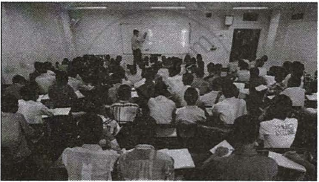Advertisements
Advertisements
Question
Find the value of k for which each of the following system of equations have no solution :
2x - ky + 3 = 0
3x + 2y - 1 = 0
Solution
The given system of the equation may be written as
2x - ky + 3 = 0
3x + 2y - 1 = 0
The system of equation is of the form
`a_1x + b_1y + c_1 = 0`
`a_2x + b_2y + c_2 = 0`
Where
`a_1 = 2, b_1 = -k, c_1 = 3`
And
`c_2 = 3, b_2 = 2, c_2 = -1`
For a unique solution, we must have
`a_1/a_2 - b_1/b_2 != c_1/c_2`
We have
`a_1/a_2 = 2/3`
and `c_1/c_2 = 3/(-1)`
Clearly, `a_1/a_2 != c_1/c_2`
So, the given system will have no solution. If
`a_1/a_2 = b_1/b_2 i.e 2/k = (-k)/2 => k = (-4)/3`
Hence, the given system of equations has no solutions `k = (-4)/3`
APPEARS IN
RELATED QUESTIONS
Aftab tells his daughter, “Seven years ago, I was seven times as old as you were then. Also, three years from now, I shall be three times as old as you will be.” (Isn’t this interesting?) Represent this situation algebraically and graphically
The cost of 2 kg of apples and 1 kg of grapes on a day was found to be Rs 160. After a month, the cost of 4 kg of apples and 2 kg of grapes is Rs 300. Represent the situation algebraically and geometrically.
Solve for x and y:
2x - 3y = 13, 7x - 2y = 20
Solve for x and y:
`(bx)/a + (ay)/b = a^2 + b^2, x + y = 2ab`
Find the value of k for which the system of linear equations has an infinite number of solutions:
2x + (k – 2)y = k,
6x + (2k - 1)y = (2k + 5).
If 2 is added to each of two given numbers, their ratio becomes 1 : 2. However, if 4 is subtracted from each of the given numbers, the ratio becomes 5 : 11. Find the numbers.
A two-digit number is 3 more than 4 times the sum of its digits. If 18 is added to the number, the digits are reversed. Find the number.
Find the value(s) of p in (i) to (iv) and p and q in (v) for the following pair of equations:
– 3x + 5y = 7 and 2px – 3y = 1,
if the lines represented by these equations are intersecting at a unique point.
Find the value(s) of p in (i) to (iv) and p and q in (v) for the following pair of equations:
2x + 3y – 5 = 0 and px – 6y – 8 = 0,
if the pair of equations has a unique solution.
Read the following passage:
|
A coaching institute of Mathematics conducts classes in two batches I and II and fees for rich and poor children are different. In batch I, there are 20 poor and 5 rich children, whereas in batch II, there are 5 poor and 25 rich children. The total monthly collection of fees from batch I is ₹9,000 and from batch II is ₹26,000. Assume that each poor child pays ₹x per month and each rich child pays ₹y per month.
|
Based on the above information, answer the following questions:
- Represent the information given above in terms of x and y.
- Find the monthly fee paid by a poor child.
OR
Find the difference in the monthly fee paid by a poor child and a rich child. - If there are 10 poor and 20 rich children in batch II, what is the total monthly collection of fees from batch II?

